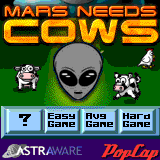Background
I was part of group 2 in a project to create a board game with some unique constraints:
- must be a farming game
- must have strategy
- must target college level players.
While brainstorming ideas, we were jokingly saying that our constraints describe the game “Settlers of Catan” almost exactly. Catan involves strategy as you try to claim territory that provide resources that you need, it has farming aspects as you exchange resources for other useful tools and resources, and it attempts to target college level players (at least in my opinion) with complicated rules, strategy, and diplomacy.
While we could use Catan as inspiration, I was thinking that would be pretty boring and cliche, so I was thinking about ways we could be considered a farming game, without a strong focus on a traditional farm.
Finding loopholes
While brainstorming, a wild old memory appeared in my head of an old Pop Cap game called “Mars needs Cows”.

Mars Needs cows by Pop Cap for the Palm Pilot (dang was this game really that old?)
Then I was wondering what if we created a game where a player is tasked with abducting farm animals from a farm? Then I also thought what if someone else was trying to fight back and defend the animals from abduction
First concept (spoilers: it sucked)
We settled on the idea of player 1 controlling farmers as they try to defend from an alien invasion, while player 2 controls the aliens as they try to destroy the farm.
Our first concept was that the farmers have a grid field where they build structures to attack an alien unit selected by player 2. A round would have been divided into 6 steps called hours. For each of the first 5 hours, the player can make a single move (and can hire more workers who would offer more moves per turn). By the six hour, the alien could attack one unit or the farmers barn directly which can end the game if the barn took 8 damage.
This concept had a lot of issues as the rules were pretty complicate to put in words without appearing confusing. The aliens also had very little to do, making that role pretty boring.
Massive overhaul
A teammate pitched the idea that the farm could be on mars. We also started to overhaul the alien’s side drawing inspiration from tower defense games like Plants vs Zombies (coincidentally also a pop cap game). Instead of placing one strong alien that the farmers try to destroy as quickly as possible, the aliens instead have a few UFOs that can spawn troops into position. The aliens draw troops from a deck and can summon as many as they want, but the troops need to be beamed into position before they can make an attack.

The UFO has 3 colored spaces under it which we called Zone 1, Zone 2, and Zone 3. Units are spawned in Zone 1 but cannot attack until they get to zone 3. (They move down one zone each turn)
We started to create a set of alien troops, like a deck of cards (I thought it was like Hearthstone cards in a way, except players don’t spend resources to summon cards). While they can summon as many as they want without spending resources, they only had 4 spaces to summon troops and they had to get the troop in position before they can attack
The 5 rounds and 1 move per round rule for farmers was also removed. Instead farmers were able to collect resources each turn which they can spend to build structures, launch attacks, or do other various actions.
Target players
The roles of the two players are very different that the game felt like it targeted multiple types of players. The aliens were very spammy and rushes the farmers, which felt perfect for players who like to obliterate their opponent as fast as possible.
Meanwhile the farmers initially start at a disadvantage as their primary focus from the start is to defend, not to attack. However, the power capacity that farmers have can be much higher than those of the aliens. This made this role feel more delicate for those that like to play for the long game and outthink their opponent.
The rules were a bit more complex, especially with both players playing two entirely different roles. However, we felt like we managed to do a good job splitting the rule sheet into two sections so each player effectively only needs to read half of the sheet to understand what role they need to play. However, each player’s vast styles and strategies also make this fit for the complex thinking of college students.